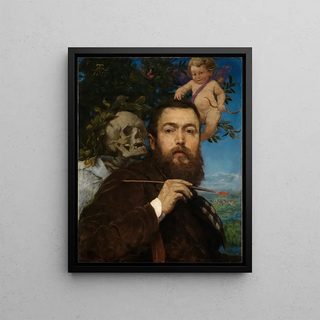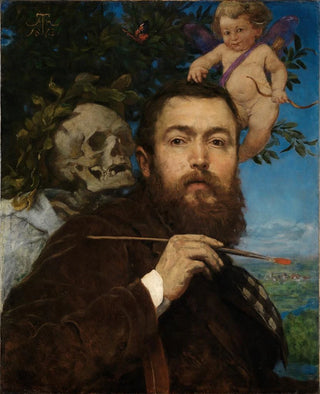Art print | Self-portrait with Cupid and Death - Hans Thoma


View from behind

Frame (optional)
The artwork "Autoportrait avec Cupidon et la Mort" by Hans Thoma presents itself as an open window into the artist's soul, a piece that transcends a simple self-portrait to delve into deeper reflections on life and death. In this composition, Thoma does not merely depict himself; he summons allegorical figures that enrich the visual narrative. Cupid, symbol of love, and Death, the inescapable figure of our existence, intertwine around him, creating a palpable tension between the forces of life and mortality. This work, both personal and universal, invites the viewer to introspection about their own realities.
Style and uniqueness of the work
Hans Thoma's style is characterized by a symbolist approach and a bold use of color. In "Autoportrait avec Cupidon et la Mort," vibrant hues and striking contrasts capture the eye and imagination. Thoma masters the art of composition, where each element finds its place in a delicate balance. The expressions of the figures, sometimes serene, sometimes troubled, reveal a psychological depth that resonates with the viewer. The way he handles light and shadow gives the scene an almost mystical atmosphere, reinforcing the idea that life and death are inseparable partners in the grand ballet of existence. This work stands out for its introspective nature, offering a reflection on the passage of time and the ephemeral nature of life.
The artist and his influence
Hans Thoma, born in 1839, was a German painter whose work was deeply influenced by Romanticism and symbolism. His artistic journey is marked by an incessant quest for meaning, a desire to translate human emotions through mythological motifs and spiritual allusions. Thoma was able to incorporate folkloric elements and references to nature, creating a rich and varied oeuvre. His influence extends beyond his era, inspiring many contemporary and future artists. By depicting universal themes such as love and death, he paved the way

Matte finish

View from behind

Frame (optional)
The artwork "Autoportrait avec Cupidon et la Mort" by Hans Thoma presents itself as an open window into the artist's soul, a piece that transcends a simple self-portrait to delve into deeper reflections on life and death. In this composition, Thoma does not merely depict himself; he summons allegorical figures that enrich the visual narrative. Cupid, symbol of love, and Death, the inescapable figure of our existence, intertwine around him, creating a palpable tension between the forces of life and mortality. This work, both personal and universal, invites the viewer to introspection about their own realities.
Style and uniqueness of the work
Hans Thoma's style is characterized by a symbolist approach and a bold use of color. In "Autoportrait avec Cupidon et la Mort," vibrant hues and striking contrasts capture the eye and imagination. Thoma masters the art of composition, where each element finds its place in a delicate balance. The expressions of the figures, sometimes serene, sometimes troubled, reveal a psychological depth that resonates with the viewer. The way he handles light and shadow gives the scene an almost mystical atmosphere, reinforcing the idea that life and death are inseparable partners in the grand ballet of existence. This work stands out for its introspective nature, offering a reflection on the passage of time and the ephemeral nature of life.
The artist and his influence
Hans Thoma, born in 1839, was a German painter whose work was deeply influenced by Romanticism and symbolism. His artistic journey is marked by an incessant quest for meaning, a desire to translate human emotions through mythological motifs and spiritual allusions. Thoma was able to incorporate folkloric elements and references to nature, creating a rich and varied oeuvre. His influence extends beyond his era, inspiring many contemporary and future artists. By depicting universal themes such as love and death, he paved the way






